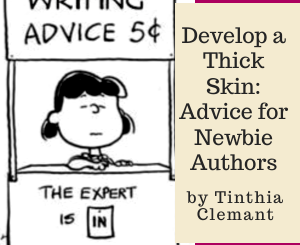Writing a Synopsis That Doesn’t Suck by Tinthia Clemant

Please welcome guest author, Tinthia Clemant as she shares with us “Writing a Synopsis That Doesn’t Suck.” Enjoy!
***
I’m a virgin when it comes to synopsis writing and I don’t want mine to suck, which, if all the blogs I’ve read are correct, probably will.

Writing a synopsis should be far easier than writing a novel? Novels clock in around 50,000 to 100,000 words while a synopsis can range from 500 to 1,500. Easy, cheesy. I just have to hack at my manuscript until all that’s left isn’t the bare bones of the story but fragments of what once were the bare bones of the story and then grind those fragments up into tiny shards, grind some more, and, bingo, I’ll have a synopsis.

Give me a minute, will you? I seem to have stopped breathing.
Okay, Phew, much better. Back to writing a synopsis. Before we can begin writing a synopsis we need to understand the reason for writing one. A synopsis is used to present a written account of a story plot AND reveal the emotional ARC(s) of the main character(s) without all the extra verbiage found in a novel. No dialogue, no back stories, no inner thoughts, no sex scenes; just the facts. Easy, cheesy, squeezy.
After doing some, and I mean SOME like in a ton of research (I’ve linked to a few of the best articles at the end of this post.), I’ve managed to come up with my top 11 list of what to do and not to do when writing a synopsis.

Sorry, wrong list.
Rules for Writing a Synopsis
Rule #1
A synopsis must be written in third person, regardless of the POV used in the story.
Rule #2
Write clearly and concisely in your own voice. Your synopsis has two purposes, to sell your book and you!
Rule #3
Character’s names should be typed in all caps and bold.
Rule #4
<Always provide a setting. Stories don’t exist in black holes and your synopsis shouldn’t either.
Rule #5
Always reveal, in the first paragraph, the status quo for your MC.
Rule #6
If you have two MC’s, offer two opening paragraphs, each with the MC’s status quo.
Rule #7
Always reveal the character’s main goal(s).
Rule #8
Offer a summary for each act.
Rule #9
Don’t spend valuable words trying to explain the story’s themes and backstories, and avoid dialogue. Also, and this is important: tell, don’t show!
Rule #10
Avoid wordiness. Mary carried the steaming, hot mug of dark chocolate hot chocolate into the cozy study where she would wait until early morning for Jeff, her one true love, to call to announce he’d arrived safely in the balmy heat of Jamaica, becomes…Mary waited until early morning for Jeff’s call. (Thank you Jane Friedman for this wonderful tidbit of guidance.)
Rule #11
Always reveal the ending; no cliffhangers allowed.

Don’t get stressed out. Relax, we got this!
Honestly, there are more than 11 rules. A lot more! But, for now, I’ll stick with these 11.
Did I mention the beginning of the synopsis? Nope! Sigh, now there are 12 rules. Rule #12: Avoid cute beginnings such as Once upon a time… or In a land, far, far away… or It was a dark and stormy night… I’m sure you get the picture. Begin with your log-line; that one sentence elevator pitch that you’ve rehearsed until you can recite it backwards. What? You don’t have a log-line? No worries, by the time you’re finished with the draft for your synopsis, you will!
The first paragraph should always introduce the character(s). I guess that makes this Rule #13. If you have two MCs, you’ll need two intro paragraphs.
Here are my rough, and I’m stressing the word rough, opening paragraphs for the synopsis I’m working on for my newest book, Breaking the Rules:
SHANNON MULLER wasn’t looking for love. She wasn’t even looking for sex. She was looking for a way out of her emotionally abusive marriage. A way she was sure she’d discover once she found her courage. Not an easy thing to do, especially when her mother’s words dog her every waking moment. ‘The Muller women need someone to take care of us.’ Even if she could silence her mother’s proclamation, she still had to find a way to escape the clutches of her gas-lighting prick of a husband. And build a new life for herself and six-year-old son. (more to come)
ADAM ST. JOHN has rules. A lot of them. All created with one goal in mind: To protect himself from disappointment and heartache. With three divorces under his belt, he doesn’t need the problems that come with relationships. After all, love is just an excuse people use to inflict pain. (more to come)
Did I mention the paragraphs are rough? Well, if I didn’t, I’ll mention it now–they’re rough! But they do show the character’s names in all caps and each character has her/his own paragraph. At least I’m heading in the right direction. Time for some ice cream.

Now it’s your turn. Have you written a synopsis? Are you struggling to write one? What tips can you add to my rules that will help those of us who are virgin synopsis writers?
Blessed be :}
***
ABOUT THE AUTHOR
 Tinthia Clemant lives in a secluded spot on the Concord River in Massachusetts. Her companions include a black Labrador/Coonhound named Harlee; Shadow, an elderly black cat who still rocks at catching mice that have wandered into the house; a few hundred wild Mallards; assorted turtles, songbirds, snakes; and hawks, two Great Blue herons, and an American bald eagle.
Tinthia Clemant lives in a secluded spot on the Concord River in Massachusetts. Her companions include a black Labrador/Coonhound named Harlee; Shadow, an elderly black cat who still rocks at catching mice that have wandered into the house; a few hundred wild Mallards; assorted turtles, songbirds, snakes; and hawks, two Great Blue herons, and an American bald eagle.
Besides writing she enjoys baking, gardening, reading (of course), painting and photography, laughing, and movies (the more explosions the better). Tinthia is an ice cream aficionado and insists that Ben and Jerry are the most perfect men ever created. She inherited my father’s temper and her mother’s view on life: It’s meant to be lived, embraced, savored, inhaled, and not given back until every last drop of wonder is claimed. If you visit Tinthia make sure you bring a bottle of bourbon and, of course, ice cream. Her favorite flavor is Chunky Monkey.







Thank you for posting my article. Squeeeeeee!
You’re so welcome! Glad to have you here! Synopses are so important!